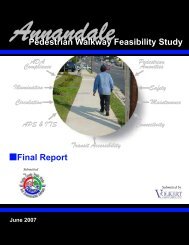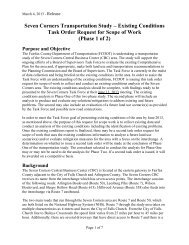Annandale Transportation Study - Fairfax County Office of ...
Annandale Transportation Study - Fairfax County Office of ...
Annandale Transportation Study - Fairfax County Office of ...
Create successful ePaper yourself
Turn your PDF publications into a flip-book with our unique Google optimized e-Paper software.
<strong>Annandale</strong> <strong>Transportation</strong> <strong>Study</strong> – Final Report<br />
7.3. Utilizing Existing Service Drive and ROW Considerations for Alternatives 2 and 5<br />
Previous estimates <strong>of</strong> the right-<strong>of</strong>-way and impacts incurred by widening Little River Turnpike have assumed that the<br />
corridor would be expanded laterally and the service drives would have to be relocated and impact current property<br />
lines. However, it was noted in the evaluation <strong>of</strong> the current and potential cross sections along Little River Turnpike<br />
for Alternatives 2 and 5 that there is more than sufficient room to widen Little River Turnpike if the service drives were<br />
removed. Table 14 summarizes existing and proposed service drive locations block-by-block along the Little River<br />
Turnpike corridor.<br />
TABLE 14: Existing and Proposed Service Drive Locations<br />
Existing Conditions Alternative 2 Alternative 5<br />
North Side South Side North Side South Side North Side South Side<br />
West <strong>of</strong> Hummer/Heritage Yes Yes Partial Yes Partial Yes<br />
Hummer to Woodlawn Yes Yes No Yes No Yes<br />
Woodlawn to Medford Yes Yes No Partial No Partial<br />
Medford to Markham Yes Yes No No No No<br />
Markham to <strong>Annandale</strong> Partial No No No No No<br />
<strong>Annandale</strong> to Backlick No No No No No No<br />
Backlick to John Marr No Yes No No No No<br />
John Marr to Carmico Yes Yes No No No No<br />
Carmico to Evergreen No No No No No No<br />
East <strong>of</strong> Evergreen No No No No No No<br />
During field observations <strong>of</strong> traffic conditions in the corridor, it was noted that many <strong>of</strong> the service drive intersections<br />
cause operational problems at both the service drive intersections with the cross streets and the cross street<br />
intersections with Little River Turnpike. Due to the close proximity <strong>of</strong> these two intersections on the crossing streets<br />
(about 40 feet separation between LRT and the service drive in most locations), the traffic signals require that greater<br />
green-time be allotted to the cross street movements to sort out all the conflicting movements, reducing the green<br />
time allotment (and thus lowering capacity) for Little River Turnpike. Closely spaced intersections can lead to<br />
increased intersection accident rates, and the current service drive design violates VDOT’s access management<br />
guidelines that recommend a minimum <strong>of</strong> 225 feet between the major street and the first service drive or driveway<br />
access.<br />
The “excess” right-<strong>of</strong>-way taken up by the current service drives could be used for:<br />
a greater boundary between the Little River Turnpike and the adjacent land uses along the corridor<br />
(potentially adding a tree-lined boundary)<br />
<br />
<br />
a greater pedestrian sidewalk, bike lane, shared path and/or transit amenities along the corridor<br />
a greater center median width (giving the corridor a parkway appearance)<br />
on-street parking<br />
or some combination there<strong>of</strong>. It is not the intent to “give-back” or sell the excess right-<strong>of</strong>-way taken up by the service<br />
drives; further study is recommended to identify the optimal use <strong>of</strong> this corridor for needed transportation amenities<br />
and/or landscaping buffers. No attempt was made within this study to define or recommend exact transportation<br />
amenities within the corridor. At the planning level, the removal <strong>of</strong> continual service drive requirements can be<br />
implemented within the VDOT access management guidelines. However, certain design level modifications (such as<br />
median break locations and future parcel access consolidation requirements) will need to be examined in detail in<br />
future analyses. The focus <strong>of</strong> the contextual design concepts is only to identify potential transportation amenity<br />
options gained by the elimination <strong>of</strong> the service drives.<br />
7.4. Right <strong>of</strong> Way Impacts for Alternatives 2 and 5<br />
As illustrated in Figures 13 and 14, Alternative 5 requires no additional right <strong>of</strong> way along any portion <strong>of</strong> the corridor<br />
assuming the removal <strong>of</strong> the service drives. The sections <strong>of</strong> LRT that are to be widened to six lanes (from<br />
Hummer/Heritage to Markham Street in the western portion <strong>of</strong> the corridor and from John Marr to Evergreen Road in<br />
the eastern part <strong>of</strong> the corridor) can be accomplished within the footprint <strong>of</strong> the existing service drives between<br />
Markham and John Marr in the heart <strong>of</strong> the CBC area, the one-way pair roadways can be implemented using only the<br />
existing pavements on LRT and McWhorter Road/John Marr Drive.<br />
In Alternative 2, there are sections in which the needed right-<strong>of</strong>-way is greater than the existing right-<strong>of</strong>-way. Figure<br />
11 shows the minimum corridor cross section needed between <strong>Annandale</strong> and Backlick Roads where there are no<br />
current service drives and a widening would require the acquisition <strong>of</strong> right-or-way on one side or both <strong>of</strong> LRT and<br />
potential impacts to structures. The improvements required in the Comprehensive Plan for the realignment <strong>of</strong><br />
<strong>Annandale</strong>/Ravensworth Road at Little River Turnpike may have additional impacts to right-<strong>of</strong>-way and properties in<br />
the vicinity <strong>of</strong> this intersection. Further study is recommended to determine the desired cross section and the extent <strong>of</strong><br />
impacts in this two-block stretch <strong>of</strong> Little River Turnpike.<br />
7.5. Access Impacts for Alternatives 2 and 5 with Utilizing Existing Service Drive ROW<br />
Under any proposed widening scenario on Little River Turnpike, VDOT will review the access management and the<br />
effectiveness <strong>of</strong> the current service drives along the corridor. Current service road connections to the cross streets<br />
along LRT violate VDOT’s Access Management Regulations (24VAC30-73-120 C 1). These provisions state that<br />
“access drives should be kept away from intersections to reduce congestion, entrance safety and prevent vehicles<br />
from backing up onto the highway”. The recommended minimum distance from the major street to the first access<br />
drive / driveway is 225 feet. Alternatives to improve access management would be to relocate the service drive<br />
intersections away from LRT (at great impact to existing development) or to remove the service drives and provide<br />
interparcel or alternative access to the properties that front Little River Turnpike. The impacts to parcel access<br />
identified in the concept plans for both Alternatives 2 and 5 were reviewed, and the parcels impacted or with existing<br />
access in non-conformity to the VDOT Access Management Plan guidelines are identified in Figures 12a-d and 14a-d<br />
respectively. Effort to consolidate driveways and increase interparcel connectivity along the Little River Turnpike<br />
corridor would lessen access impacts and should be encouraged.<br />
7.6. Project Termini Transitions<br />
The <strong>Annandale</strong> Comprehensive <strong>Transportation</strong> Plan calls for Little River Turnpike to be widened to six lanes through<br />
the <strong>Annandale</strong> CBC area. Little River Turnpike is currently six lanes between I-495 and Hummer/Heritage Road. Both<br />
Alternatives 2 and 5 widen Little River Turnpike to a six lane divided roadway beginning at Hummer/Heritage Road to<br />
match the existing six lane section to the west. Both Alternatives 2 and 5 also widen Little River Turnpike to six lanes<br />
between John Marr Drive and Evergreen Lane. East <strong>of</strong> Evergreen Lane, Little River Turnpike transitions from a six to<br />
four lane divided section as the area changes from the urban CBC area to a suburban area with fewer driveways and<br />
greater spacing between signalized intersections. In the eastbound direction, three lanes are pulled though the<br />
Evergreen Lane signalized intersection and the right lane is merged at a safe and effective distance from the<br />
Evergreen Lane intersection (+/- 1,000 feet beyond the signal). In the westbound direction, a third lane is formed prior<br />
to the Evergreen Lane intersection to allow adequate storage at the Evergreen Lane signal.<br />
Between Markham Street and John Marr Drive, Alternatives 2 and 5 differ but provide the same number <strong>of</strong> through<br />
travel lanes. Alternative 2 widens Little River Turnpike to six lanes, three in each direction. Alternative 5 provides three<br />
westbound travel lanes on Little River Turnpike (without widening) and provides three westbound travel lanes on<br />
parallel one-way pair route using Markham, McWhorter and John Marr Driver. Therefore, in both Alternatives 2 and 5,<br />
three through lanes <strong>of</strong> travel are provided in each direction between Hummer/Heritage and Evergreen Lane.<br />
7.7. Multimodal Impacts<br />
In general, both improvement Alternatives 2 and 5 have positive impacts on the multimodal aspects <strong>of</strong> the corridor.<br />
Certainly auto mobility is improved by the increase in roadway capacity under both alternatives. Also, in most sections<br />
<strong>of</strong> the corridor there is ample room for the improvement and expansion <strong>of</strong> sidewalk and bike facilities. Where the<br />
available right-<strong>of</strong>-way lessens and there is the potential for property impacts along Little River Turnpike in Alternative<br />
April 2010<br />
32





